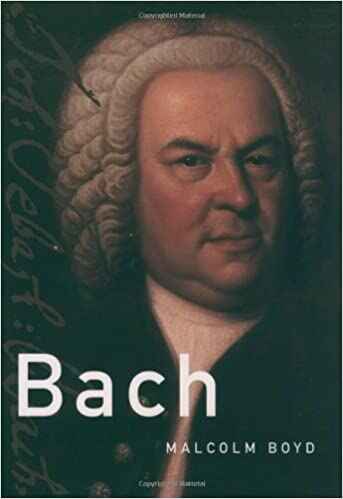
Malcolm Boyd’s Bach-biography from 1983 has been re-issued in German in the year 2000 by DVA. It covers the life and work of Johann Sebastian Bach, who died 250 years ago [English edition by OUP, 2001: Amazon.com, Amazon.co.uk.]. The author examines in detail the Bach-dynasty of musicians. Having several generations of a family dedicated to music was nothing unusual at that time, as the examples of the Scarlatti’s in Italy, the Couperin’s in France and the Purcell’s in England show, just to mention the outstanding dynasties.
According to Boyd, Johann Sebastian Bach, born in 1685 in Eisenach, needed a window to open him up new horizons, a catalyst that could help him develop his mature style. After having worked in some minor cities, Weimar became the window, Vivaldi and the style of the Italian modern concert the catalyst. Bach worked there as choirmaster and organist (Kantor) from 1708 to 1717. Afterwards, from 1717 to 1723, he moved to Köthen, situated one hundred kilometers north of Weimar. The city was the residence of the Prince of Anhalt-Köthen since 1603. In Bach’s time, Prince Leopold was a good violinist, gambist, cellist and bass singer. But after his marriage in December 1721, it quickly became clear that his wife did not share the Prince’s passion for music – and for the arts in general. Bach later called her an “amusa”. Half a year after his marriage, Prince Leopold died and Bach soon moved to Leipzig – a change not easily made, Bach was not the first choice for the city’s officials, for whom he was to work the following 26 years until his death. Leipzig was, after Dresden, the most important city of Saxony, with one of the most notable and advanced universities in Germany, founded in 1409. Furthermore the leading position of Leipzig as Germany’s center of book edition and commerce was undisputed.
The contemporary sources do not tell us much about Bach’s attitude towards religious questions or the philosophical disputes of his time. But the character of the composer becomes feasible in the disputes with his superiors and members of his chorus: Bach was a determined, even stubborn man when faced with obstacles.
Boyd divides Bach’s development as a composer into three stylistic periods: the years of apprenticeship until 1713, the years as a master until 1739/40, and the years of completion until his death in the year 1750. Until 1713, Bach wrote above all works for organ, piano and “a few cantatas”. In the second stylistic period in Weimar, he was influenced by modern Italian music, especially the concerto. Clear melodic characteristics, concise rhythm, a new feeling for tonality and its background, especially the importance of cadences resulted from the encounter with Italian music. Bach mixed it with the sobriety of the Lutheran choral, with the rich middle part movement and the preference of Northern countries for counterpoints. The result was a distinctive, individual style that could apply to all musical genres. In his late work, Bach was – like Beethoven – able to go “beyond human consciousness”.
In his comparison between the great masters of late Baroque, Boyd comes to the conclusion that Händel and Bach had only a few things in common. Händel excelled in genres Bach did not touch (opera, oratorio and the concert in the form of Corelli). Bach wrote his most important works in fields Händel did not work in (Church cantata, Passion oratorio, mass, the concerto in the form of Vivaldi). Secular music was the center of Händel’s work as was religious music for Bach. Händel cared about the big dimensions in music which he approached vocally, rich in melodies and with Italian at its core whereas Bach’s compositions show technical abilities, the master craftsman until the last detail, they are approached instrumentally, the counterpoint is essential and they are German at the core. Moreover, Bach’s works contain greater technical difficulties than those of any other composition of the 18th century.
The intellectual and technical density of Bach’s compositions hindered their spreading during his lifetime. Among those who appreciated his work were Mozart and Beethoven. In 1827, the year of Beethoven’s death, Bach had already taken his place as an eternal composer besides Händel, Haydn and Mozart in the German consciousness.
Besides Bach’s life, Boyd’s biography also examines his compositions, the works for organ (choral, preludes, fugues, etc.), the works for orchestra, chamber music and piano, the sacred music composed in Leipzig (cantatas, motets, Magnificat, passions), the oratorios and masses, the concertos for cembalo, the “exercises” for piano, the canons as well as his use of the counterpoint. Especially in regard to the examination of the compositions, Malcolm Boyd’s book is the ideal complement to the new Bach-biography by Christoph Wolff.
English edition: Malcolm Boyd: Bach (Master Musicians Series), 1997 (first published in German in 1983). Get the English edition from the year 2001, Oxford University Press, 344 pages, from Amazon.com, Amazon.co.uk.
Read the German article about the German edition of Malcolm Boyd’s biography.
Read the English article about Christoph Wolff’s Bach biography.
Article added on June 1, 2000.